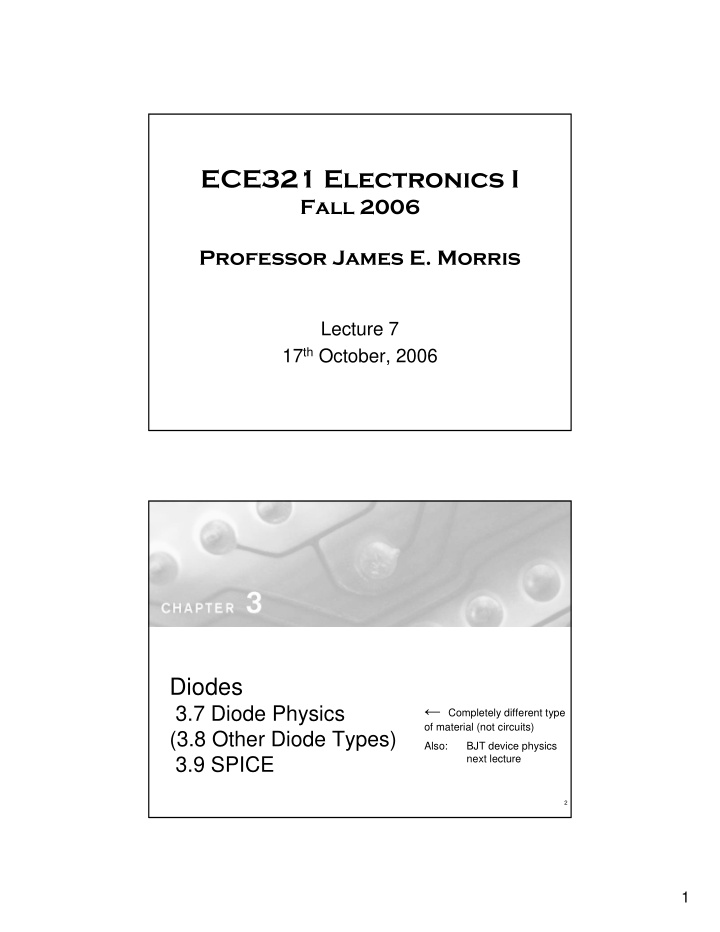



ECE321 Electronics I Fall 2006 Professor James E. Morris Lecture 7 17 th October, 2006 Diodes ← Completely different type 3.7 Diode Physics of material (not circuits) (3.8 Other Diode Types) Also: BJT device physics next lecture 3.9 SPICE 2 1
Figure 3.39 Simplified physical structure of the junction diode. (Actual geometries are given in Appendix A.) Figure 3.40 Two-dimensional representation of the silicon crystal. The circles represent the inner core of silicon atoms, with +4 indicating its positive charge of +4q, which is neutralized by the charge of the four valence electrons. Observe how the covalent bonds are formed by sharing of the valence electrons. At 0 K, all bonds are intact and no free electrons are available for current conduction. 2
Figure 3.41 At room temperature, some of the covalent bonds are broken by thermal ionization. Each broken bond gives rise to a free electron and a hole, both of which become available for current conduction. Figure 3.42 A bar of intrinsic silicon (a) in which the hole concentration profile shown in (b) has been created along the x- axis by some unspecified mechanism. 3
Figure 3.43 A silicon crystal doped by a pentavalent element. Each dopant atom donates a free electron and is thus called a donor. The doped semiconductor becomes n type. Figure 3.44 A silicon crystal doped with a trivalent impurity. Each dopant atom gives rise to a hole, and the semiconductor becomes p type. 4
Figure 3.45 (a) The pn junction with no applied voltage (open-circuited terminals). (b) The potential distribution along an axis perpendicular to the junction. Figure 3.46 The pn junction excited by a constant-current source I in the reverse direction. To avoid breakdown, I is kept smaller than I S . Note that the depletion layer widens and the barrier voltage increases by V R volts, which appears between the terminals as a reverse voltage. 5
Figure 3.47 The charge stored on either side of the depletion layer as a function of the reverse voltage V R . Figure 3.48 The pn junction excited by a reverse-current source I , where I > I S . The junction breaks down, and a voltage V Z , with the polarity indicated, develops across the junction. 6
Figure 3.49 The pn junction excited by a constant-current source supplying a current I in the forward direction. The depletion layer narrows and the barrier voltage decreases by V volts, which appears as an external voltage in the forward direction. Figure 3.50 Minority-carrier distribution in a forward-biased pn junction. It is assumed that the p region is more heavily doped than the n region; N A @ N D . 7
Figure 3.51 The SPICE diode model. Figure 3.52 Equivalent-circuit model used to simulate the zener diode in SPICE. Diode D 1 is ideal and can be approximated in SPICE by using a very small value for n (say n = 0.01). 8
Figure 3.53 Capture schematic of the 5-V dc power supply in Example 3.10. Figure 3.54 The voltage v C across the smoothing capacitor C and the voltage v O across the load resistor R load = 200 Ω in the 5-V power supply of Example 3.10. 9
Figure 3.55 The output-voltage waveform from the 5-V power supply (in Example 3.10) for various load resistances: R load = 500 Ω , 250 Ω , 200 Ω , and 150 Ω . The voltage regulation is lost at a load resistance of 150 Ω . Figure E3.35 (a) Capture schematic of the voltage-doubler circuit (in Exercise 3.35). 10
Figure E3.35 (Continued) (b) Various voltage waveforms in the voltage-doubler circuit. The top graph displays the input sine-wave voltage signal, the middle graph displays the voltage across diode D 1 , and the bottom graph displays the voltage that appears at the output. 11
Recommend
More recommend